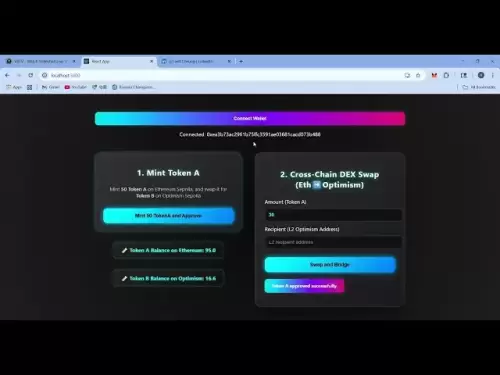-
 Bitcoin
Bitcoin $109,459.7682
2.44% -
 Ethereum
Ethereum $2,598.6052
6.29% -
 Tether USDt
Tether USDt $1.0003
0.00% -
 XRP
XRP $2.2734
3.95% -
 BNB
BNB $661.4886
1.58% -
 Solana
Solana $155.4825
4.35% -
 USDC
USDC $0.9999
-0.02% -
 TRON
TRON $0.2838
1.04% -
 Dogecoin
Dogecoin $0.1740
8.25% -
 Cardano
Cardano $0.6047
9.04% -
 Hyperliquid
Hyperliquid $40.2302
6.50% -
 Sui
Sui $2.9863
10.05% -
 Bitcoin Cash
Bitcoin Cash $509.5786
0.60% -
 Chainlink
Chainlink $13.8156
6.03% -
 UNUS SED LEO
UNUS SED LEO $9.0142
0.69% -
 Avalanche
Avalanche $19.0337
8.68% -
 Stellar
Stellar $0.2438
5.17% -
 Toncoin
Toncoin $2.9012
3.59% -
 Shiba Inu
Shiba Inu $0.0...01210
6.20% -
 Litecoin
Litecoin $90.0882
7.05% -
 Hedera
Hedera $0.1597
8.53% -
 Monero
Monero $326.3340
2.88% -
 Polkadot
Polkadot $3.6365
9.32% -
 Bitget Token
Bitget Token $4.6162
2.72% -
 Dai
Dai $1.0001
0.00% -
 Ethena USDe
Ethena USDe $1.0002
-0.01% -
 Uniswap
Uniswap $7.6403
10.47% -
 Pepe
Pepe $0.0...01060
12.03% -
 Aave
Aave $281.3664
7.56% -
 Pi
Pi $0.4992
1.76%
How to calculate Binance leverage fee
To assess the cost of utilizing borrowed funds for leveraged trading on Binance, calculate the leverage fee using the formula: (Borrowed Funds x Loan Duration x Interest Rate) / 100.
Nov 17, 2024 at 01:52 am

How to Calculate Binance Leverage Fee
Binance is a cryptocurrency exchange that allows users to trade a variety of digital assets. In addition to spot trading, Binance also offers margin trading, which allows users to borrow funds to trade with. This can be a useful way to increase your potential profits, but it also comes with some risks.
One of the most important things to understand about margin trading is the leverage fee. This is a fee that Binance charges for the use of borrowed funds. The leverage fee is calculated based on the following factors:
- The amount of borrowed funds
- The duration of the loan
- The interest rate
The leverage fee is typically expressed as a percentage of the borrowed funds. For example, a leverage fee of 0.1% would mean that you would pay $0.10 for every $100 that you borrow.
The duration of the loan is also an important factor in determining the leverage fee. The longer the loan, the higher the leverage fee will be. This is because Binance needs to compensate itself for the risk of lending you money for a longer period of time.
Finally, the interest rate also affects the leverage fee. The higher the interest rate, the higher the leverage fee will be. This is because Binance needs to charge a higher interest rate to cover its costs of borrowing money.
To calculate the leverage fee, you can use the following formula:
Leverage fee = (Amount of borrowed funds * Duration of the loan * Interest rate) / 100For example, if you borrow $100 for a period of one day and the interest rate is 1%, the leverage fee would be:
Leverage fee = (100 * 1 * 1) / 100 = $0.10Here are some additional things to keep in mind about the Binance leverage fee:
- The leverage fee is charged on a daily basis.
- The leverage fee is deducted from your account balance.
- The leverage fee is not refundable.
It is important to factor the leverage fee into your trading strategy. The leverage fee can reduce your profits, so it is important to make sure that you are only borrowing funds if you are confident that you can make a profit.
Steps to Calculate Binance Leverage Fee
- Calculate the amount of borrowed funds. This is the amount of money that you are borrowing from Binance to trade with.
- Calculate the duration of the loan. This is the length of time that you will be borrowing the funds for.
- Calculate the interest rate. Binance charges an interest rate on all loans. The interest rate varies depending on the amount of funds that you are borrowing and the duration of the loan.
- Use the formula provided above to calculate the leverage fee.
Here is an example of how to calculate the leverage fee:
- You borrow $100 from Binance to trade with.
- You borrow the funds for a period of one day.
- The interest rate is 1%.
The leverage fee would be:
Leverage fee = (100 * 1 * 1) / 100 = $0.10This means that you would pay $0.10 in leverage fees for each day that you borrow the funds.
Disclaimer:info@kdj.com
The information provided is not trading advice. kdj.com does not assume any responsibility for any investments made based on the information provided in this article. Cryptocurrencies are highly volatile and it is highly recommended that you invest with caution after thorough research!
If you believe that the content used on this website infringes your copyright, please contact us immediately (info@kdj.com) and we will delete it promptly.
- Coinbase's Crypto Conquest: The Liquifi Acquisition and the Token Revolution
- 2025-07-03 16:30:12
- Neo Pepe Coin: Can This Meme Coin Make Waves in the 2025 Crypto Market?
- 2025-07-03 16:50:12
- Toncoin, Dogecoin, and Shiba Inu: A Wild Ride in the Crypto Zoo
- 2025-07-03 16:30:12
- AllScale: Stablecoin Solutions Empowering Small Businesses – A New York Perspective
- 2025-07-03 16:35:12
- Neo Pepe Coin Presale: Is This Meme Coin a Serious Crypto Investment?
- 2025-07-03 17:10:11
- Memecoins to Buy in July 2025: Riding the Hype or Investing Wisely?
- 2025-07-03 17:10:11
Related knowledge

How to identify the contract value range in combination with the market profile?
Jul 02,2025 at 10:56pm
Understanding the Market ProfileTo effectively identify the contract value range in combination with the market profile, it's essential to first understand what each concept entails. The market profile is a framework that helps traders visualize how price and time interact across a given period, typically a trading day or session. It provides insights i...

How to use the price slope to filter the false breakthrough signal of the contract?
Jun 20,2025 at 06:56pm
Understanding the Concept of Price Slope in Contract TradingIn contract trading, especially within cryptocurrency derivatives markets, price slope refers to the rate at which the price changes over a specific time period. It helps traders assess the strength and sustainability of a trend. A steep slope may indicate strong momentum, while a shallow slope...

How to determine the expected volatility of the contract through the volatility cone?
Jun 19,2025 at 12:28pm
Understanding the Basics of Volatility in Cryptocurrency ContractsIn the realm of cryptocurrency trading, volatility is a key metric that traders use to assess potential risk and reward. When dealing with futures contracts, understanding how volatile an asset might become over time is crucial for position sizing, risk management, and strategy developmen...

How to formulate a contract intraday trading plan in combination with the pivot point system?
Jun 21,2025 at 03:42pm
Understanding the Basics of Pivot Points in Cryptocurrency TradingPivot points are technical analysis tools used by traders to identify potential support and resistance levels. These levels are calculated using the previous day's high, low, and closing prices. In the context of cryptocurrency trading, where markets operate 24/7, pivot points help trader...

How to adjust the contract position ratio through the price fluctuation entropy?
Jun 22,2025 at 11:42am
Understanding Price Fluctuation Entropy in Cryptocurrency ContractsIn the world of cryptocurrency futures trading, price fluctuation entropy is a relatively new concept used to measure market volatility and uncertainty. It derives from information theory, where entropy refers to the degree of randomness or unpredictability in a system. In crypto contrac...

How to use the volume swing indicator to predict the contract volume-price divergence?
Jun 18,2025 at 11:42pm
Understanding the Volume Swing IndicatorThe volume swing indicator is a technical analysis tool used primarily in cryptocurrency trading to evaluate changes in volume over time. Unlike price-based indicators, this metric focuses solely on trading volume, which can provide early signals about potential market reversals or continuations. The key idea behi...

How to identify the contract value range in combination with the market profile?
Jul 02,2025 at 10:56pm
Understanding the Market ProfileTo effectively identify the contract value range in combination with the market profile, it's essential to first understand what each concept entails. The market profile is a framework that helps traders visualize how price and time interact across a given period, typically a trading day or session. It provides insights i...

How to use the price slope to filter the false breakthrough signal of the contract?
Jun 20,2025 at 06:56pm
Understanding the Concept of Price Slope in Contract TradingIn contract trading, especially within cryptocurrency derivatives markets, price slope refers to the rate at which the price changes over a specific time period. It helps traders assess the strength and sustainability of a trend. A steep slope may indicate strong momentum, while a shallow slope...

How to determine the expected volatility of the contract through the volatility cone?
Jun 19,2025 at 12:28pm
Understanding the Basics of Volatility in Cryptocurrency ContractsIn the realm of cryptocurrency trading, volatility is a key metric that traders use to assess potential risk and reward. When dealing with futures contracts, understanding how volatile an asset might become over time is crucial for position sizing, risk management, and strategy developmen...

How to formulate a contract intraday trading plan in combination with the pivot point system?
Jun 21,2025 at 03:42pm
Understanding the Basics of Pivot Points in Cryptocurrency TradingPivot points are technical analysis tools used by traders to identify potential support and resistance levels. These levels are calculated using the previous day's high, low, and closing prices. In the context of cryptocurrency trading, where markets operate 24/7, pivot points help trader...

How to adjust the contract position ratio through the price fluctuation entropy?
Jun 22,2025 at 11:42am
Understanding Price Fluctuation Entropy in Cryptocurrency ContractsIn the world of cryptocurrency futures trading, price fluctuation entropy is a relatively new concept used to measure market volatility and uncertainty. It derives from information theory, where entropy refers to the degree of randomness or unpredictability in a system. In crypto contrac...

How to use the volume swing indicator to predict the contract volume-price divergence?
Jun 18,2025 at 11:42pm
Understanding the Volume Swing IndicatorThe volume swing indicator is a technical analysis tool used primarily in cryptocurrency trading to evaluate changes in volume over time. Unlike price-based indicators, this metric focuses solely on trading volume, which can provide early signals about potential market reversals or continuations. The key idea behi...
See all articles

























































































